Difference Between Beef Fat and Suet
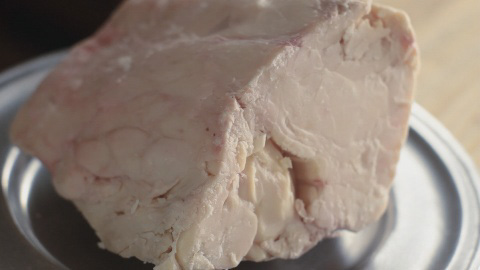
Beefiness suet
In my terminal post, I took a brief look at the important role suet had in 18th century foodways every bit well as in life in full general. I gave an over-simplified explanation that suet is the difficult fat from the loins of beef and mutton. I'd like to add together a little more meat, and so to speak, to that definition.
Beef suet tin can sometimes be a bit hard to find here in the United States. I suspect that much of it ends upwardly rendered, mixed with peanut butter and birdfeed, and packaged into blocks of winter-time bird food. Suet is a perfect loftier-caloric attraction for all my feathered friends who determine to stick out the cold northern winter with me.
I recently stopped at a well-respected butcher's shop in the surface area. After my unsuccessful search for suet at five local grocery shop meat departments, I was pleased when the butcher trotted out of the libation with a 10-pound purse of the white stuff. My pleasance turned to disappointment, nevertheless, when I opened the handbag at domicile to discover that he had just hoodwinked me with 10 pounds of hard muscle fatty. It's not the aforementioned affair.
Real suet is located on the inside of loin surface area of cattle and sheep. Information technology is the hard fat that surrounds the animate being'south kidneys. If you inquire your butcher for suet, be certain he or she understands that you want kidney fat.
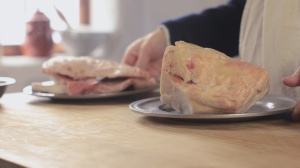
Muscle fat (left), suet (correct)
The difference betwixt hard muscle fat and kidney fatty may not be all that credible upwardly front. They both can be quite stiff and look much akin. The existent departure can seen during and post-obit the rendering process.
Suet, as opposed to muscle fatty, contains a higher level of a triglyceride known every bit glyceryl tristearate, otherwise known as stearin. The result is that suet has a higher melting point and congealing bespeak than regular fat.
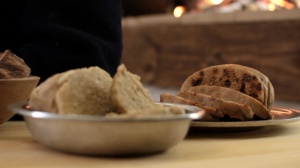
Boiled Puddings
This niggling indicate of trivia is important in order to understand the old English language recipes. Suet is grated or picked into small pieces as part of the procedure of preparing it for cooking. When mixed with other ingredients — let's say the a concoction for a traditional boiled pudding, the particles of suet retain their mass well into the cooking process. When the melting point of suet is finally reached, the surrounding batter has already begun to set up. By the time total baking temperature is reached within the pudding, the suet has melted, leaving a void in the concoction.
Consequently, the use of suet in such dishes equally puddings, dumplings, and mince pie results in a spongy texture. If the lower-melting muscle fat is used in suet's place, the fatty will melt before the batter has a gamble to prepare, resulting in a much heavier final result.
Not only is suet used for textural purposes, just information technology is also used to add moisture to the dish without adding a potent meaty flavor that is and then common with muscle fat. Suet has a much milder flavor.
I went alee, for experimentation purposes, and rendered some of the musculus fatty the butcher passed off to me equally suet. Across the fact that my entire house smelled for three days like 1 behemothic baked steak, the rendered fat I ended up with resembled a side dish of my grandma'south runny mashed potatoes. But unlike my grandma'south mashed potatoes, my rendered muscle fatty never hardened, even when it was common cold.
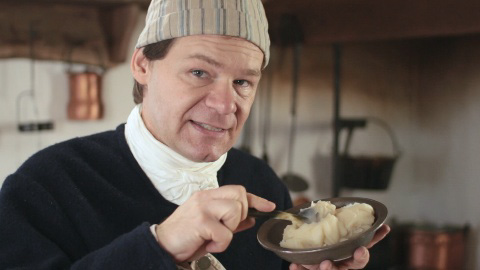
Jon with a bowl of rendered muscle fatty
This may seem foreign, but I generally go along a couple of gallons of commercially rendered tallow within accomplish here at the office. I apply it to make a couple of products here at Jas. Townsend & Son. "Tallow" is a general term that ways rendered fat. Tallow can exist made from suet, or muscle fatty, or a combination of both. The texture of tallow varies broadly, yet, depending on the raw form of fat from which its made. And then if you find yourself someday in the reenacting mood to make tallow candles, this is an important flake of information to know. You merely cannot make candles with tallow rendered from muscle fat.

Jon with a solid bar of rendered suet
Rendered suet, on the other hand, will ossify into a solid chunk. (I'll talk well-nigh the actually rendering process in my adjacent mail service.) The clamper I made felt similar a bar of beauty soap. Mix rendered suet with a trivial lye and a chemical reaction occurs that results in h2o-soluble sodium stearate — the master ingredient in about hand soaps.
Oh, one other thing: Simply similar beef muscle fatty, pork lard is an unsatisfactory substitute for suet. You may have a hard time distinguishing past sight between a lump of lard and a lump of suet tallow, but don't even think about using information technology equally a substitute.
Now in my previous mail service on 18th century Christmas pies, every bit well as in the accompanying video, we suggested using vegetable shortening as a suet substitute. Absolutely, it's not a very skillful substitute, but it does provide the moisture without adding a strong flavor.
The trouble is that while vegetable shortening'south melting point is relatively the same every bit suet, its congealing point is much lower. What that means is this: when we shot the video, we had to freeze the vegetable shortening in society to grate it. Then nosotros had to go along it frozen until the very last second. But fifty-fifty then, the moment we added the grated vegetable shortening to the other ingredients, it lost its mass and acted similar room-temperature butter, coating the other ingredients rather than retaining its particle shape. The final result was nonetheless a succulent pie, but it didn't have the desired spongy texture that would have resulted from using suet.
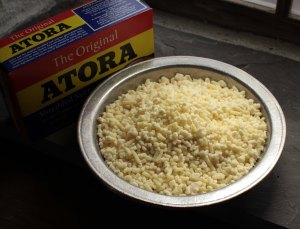
Now, if you live in the U.K., you're probably wondering why I suggest going through the hassle of dealing with raw suet when all you have to do is stroll down to the corner grocer and choice up a box of processed suet. While I'yard certain there are stores here in united states that sell this production, I certain tin can't discover it here in northern Indiana. We had to become online to buy a box, which ended up going through customs to become here.
If you determine to apply this processed production in your 18th century foodie experiments, beware that it uses wheat flour (fifteen% past weight) every bit a stabilizer to improve its ability to retain its shape. From a historical-accuracy standpoint, the addition of flour may exist perfectly legitimate. William Kitchiner, in his 1817 volume, "The Cook's Oracle," suggests that during hot weather condition, shredded suet should be dredged with flour — apparently to stabilize its mass retention.
The caveat I offer is that if y'all are already using flour in your 18th century recipe in addition to that used in processed suet, you may have to make a small-scale adjustment to the amount of flour in order to become authentic results. Modern recipes that telephone call for suet, past the way, already adjust this additional flour.
And finally, when shopping for suet, endeavor to become the whitest suet you tin can find. This petty tidbit is reiterated throughout the old cookbooks. Suet tends to turn a buttery yellow equally information technology ages, and as it does, information technology also takes on a stronger flavor. Most beef offered for auction here in u.s.a. is anile. This may pose an additional challenge in finding fresh suet. A processor who really slaughters the animal is probably your all-time bet for finding the freshest suet. A low-cal buttery colored xanthous suet is still usable, but a clean white suet is preferred. And for goodness sake, don't have suet that is brown or massively bloody. That may be fine for the birds, merely it'south unsuitable for cooking.
In my next postal service, I'll examine more closely how to procedure suet for use in cooking.
Source: https://savoringthepast.net/2013/01/21/suet-part-two-what-it-is-what-it-isnt-and-what-to-look-for/
0 Response to "Difference Between Beef Fat and Suet"
Post a Comment